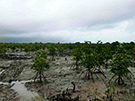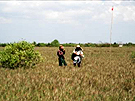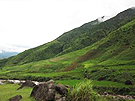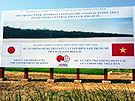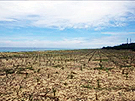International Consulting
Forestry
Myanmar
| Title | : | Second Preparatory Study for Mangrove Rehabilitation Plan for Enhancement of Disaster Prevention in the Ayeyawady Delta |
| Period | : | December 2010 – |
| Funded by | : | Japanese Grant Aid, JICA |
Mangroves are disappearing at an alarming rate in Myanmar, especially in the project site, Ayeyawady Delta. Serious damage to mangroves is also caused by cyclones which are common in this area. On the other hand, mangroves are identified as an effective measure for reducing the risk of disasters such as by preventing seawater intrusion and land erosion by seawater during a cyclone.
This project involved extensive planting of mangrove forests, building of cyclone shelters, and provision of machinery.
Papua New Guinea
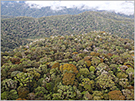 Helicopter survey of diverse, old-growth forest in PNG
Helicopter survey of diverse, old-growth forest in PNG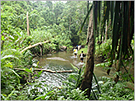 Field survey of a tropical rain forest
Field survey of a tropical rain forest
| Title | : | Forest Conservation Program / Capacity Development on Forest Resource Monitoring for Addressing Climate Change |
| Period | : | June 2011 – March 2014 |
| Funded by | : | Japanese Grant Aid and JICA |
In Papua New Guinea (PNG), sustainable conservation and management of forests is one of the most important measures for adaptation to and mitigation of climate change. The objective of this project is to develop the capacity of senior personnel in the inventory and mapping department, policy and planning directorate of the Forest Authority, for the utilization of satellite imagery and GIS/database to monitor the country’s vast forest resources.
Specifically, Kokusai Kogyo will work with relevant organizations in PNG to strengthen their capacity to monitor forest resources including carbon stock so as to promote measures against climate change, which is the main objective of the project. Moreover, we will improve:
- 1. the national forest cover map using remote sensing technologies,
- 2. the forest resource database, and
- 3. he system to monitor forest resources including carbon stock for the promotion of measures against climate change.
To achieve the above specific objectives, and to carry out the subsequent technical assistance project, various equipment will be procured – satellite imagery and aerial survey data such as LiDAR, software for remote sensing and GIS database, and field surveying equipment – under Japan’s Grant Aid for Environment and Climate Change. We will also develop a two-dimensional forest base map using optical satellite images, and estimate three-dimensional spatial volume of PNG’s forests based on analysis of field surveys. The estimated spatial volume will then be used for biomass modeling. Such data will be vital in conserving PNG’s forests, and consequently, help mitigate climate change.
Cambodia, Vietnam and Lao People’s Democratic Republic
| Title | : | Data Collection Survey on Establishment of Climate Change Monitoring System in Mekong Countries |
| Period | : | July 2010 – November 2010 |
| Funded by | : | JICA |
The Japanese government has placed a high priority on giving greater assistance to developing countries to combat climate change. Cambodia, Vietnam and Laos, the least developed ASEAN countries, are in particular need of support in their efforts against climate change to narrow the development gap towards ASEAN integration. In this light, this study was carried out to understand the current conditions and challenges in the climate change sector of the three countries.
In the study, Kokusai Kogyo also proposed basic policies, data types and network structures of a cross-sectoral climate change monitoring system, which was considered as one of the promising assistance components for climate covering three countries.
Lao People’s Democratic Republic
| Title | : | Program for Forest Information Management |
| Period | : | September 2009 – Present |
| Funded by | : | Japanese Grant Aid |
In Laos, where the economy is heavily dependant on forest resources, decreasing forest area and deteriorating forest resources is of dire concern. The Lao government has developed several laws and regulations on forest management, and expressed its commitment to promote REDD activities.
For forest conservation towards REDD to be effective it is vital to improve infrastructure of forest resource information based on satellite image analysis. This project aims to assist Department of Forestry of Ministry of Agriculture and Forestry to appropriately manage forest resource information necessary to promote REDD by
| – | constructing the Forest Resource Information Center, |
| – | providing computer equipment for satellite image analysis, and |
| – | developing technical skills for forest surveys. |
Kokusai Kogyo carried out the basic design study, and is providing consulting services for supervision and technical assistance under Japan International Cooperation System.
Vietnam
| Title | : | Project for Afforestation on the Coastal Sandy Area in Southern Central Vietnam (Phase II) |
| Period | : | January 2008 – Present |
| Funded by | : | Japanese Grant Aid |
Vietnam’s forest cover has declined from 1,400 ha in 1945 to 930 ha in 1995 as a result of years of war and an increasing population. As a result, strong winds and blown sand have been damaging agricultural crops, infrastructure, and daily life of people in coastal areas. The Vietnamese government worked out a national plan to reforest 500 ha of coastline, while the Japanese government provided assistance in the form of a grant for this afforestation, the first phase of this project in 2005. The second phase, now being supervised by Kokusai Kogyo, will restore 892 ha of coastal forest in Quang Nam and Quang Ngai provinces.
This work will mitigate the adverse effect of strong winds, blown sand and sand movements on farmland, residential areas, roads and railways, and be beneficial to the local environment.
Myanmar
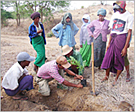 Participatory tree planting in Myanmar
Participatory tree planting in Myanmar
| Title | : | Afforestation Project in the Dry Zone |
| Period | : | May 2001 – October 2008 |
| Funded by | : | Japanese Grant Aid |
Myanmar’s dry zone is inhabited by about 15 million people, one third of the national population. An increase in population accompanied by an increase in demand for fuel wood has led to a drastic reduction of forest resources. Furthermore, the reduction in forest lands has led to soil degradation, which has brought about a decrease in the productivity of agricultural lands.
In order to establish an afforestation model and to extend planting activities in the dry zone, Kokusai Kogyo developed an afforestation plan for Myethindwin Protected Public Forest in Nyaung Oo Township in the Mandalay Division. Specifically, we planned the land development of the afforestation area, the construction of an administration office and a workshop, the procurement of equipment necessary for management and expansion of the forested area, and afforestation in an area of about 2,000 ha.
Subsequently, Japanese grant assistance was approved to achieve the aforementioned plan under the supervision of Kokusai Kogyo. The project included the procurement of tractors and trucks necessary for afforestation, the development of 43-km-long temporary road, the construction of deep wells with elevated water tanks and a management office, and the planting of 760,000 trees. Further, participatory activities were carried out whereby the local residents were encouraged to jointly manage community forest so that they could make a living without cutting afforested trees. Although the project encountered difficulties of social instability due to political confusion and natural disasters, it was successfully completed and we received a citation from Ministry of Forestry of Myanmar.
Sort by region
| Geospatial Information | Forestry | Disaster Risk Reduction | Energy |
| Water and Sanitation | Agriculture | Urban Development | Others |
Sort by sector
| Asia | Middle East | Europe | Africa |
| South and Central America | Oceania | Worldwide |


